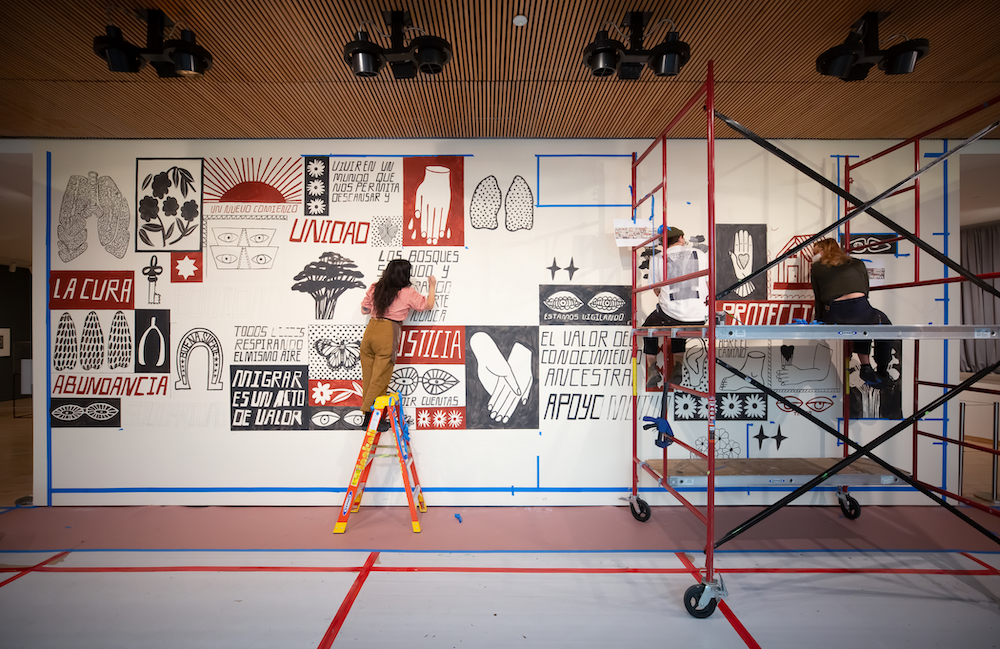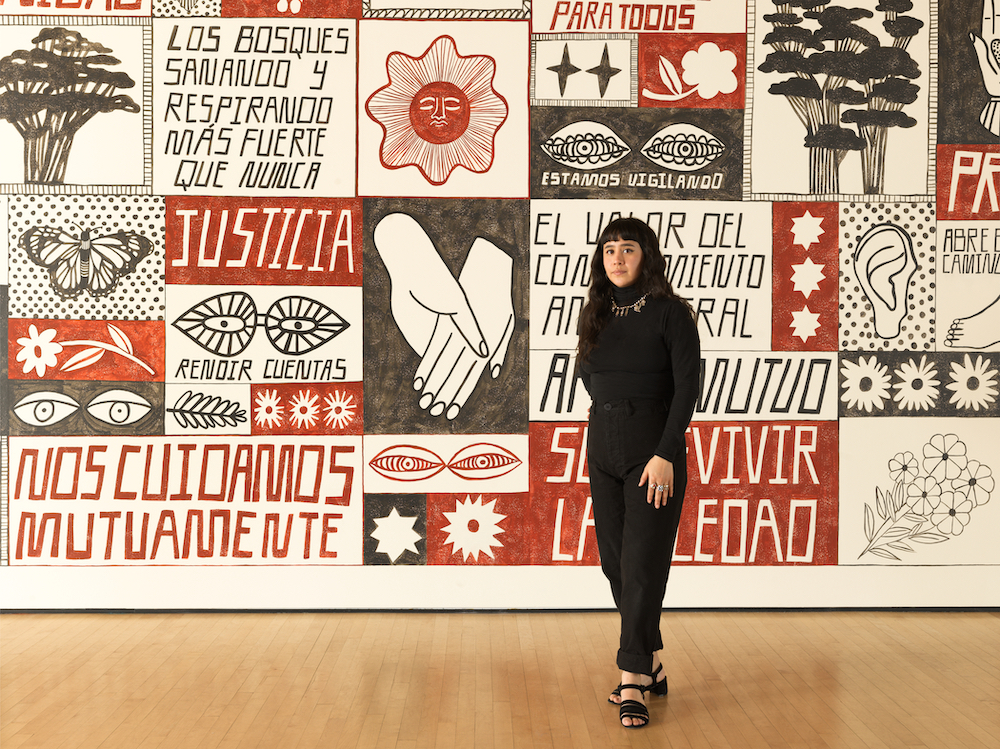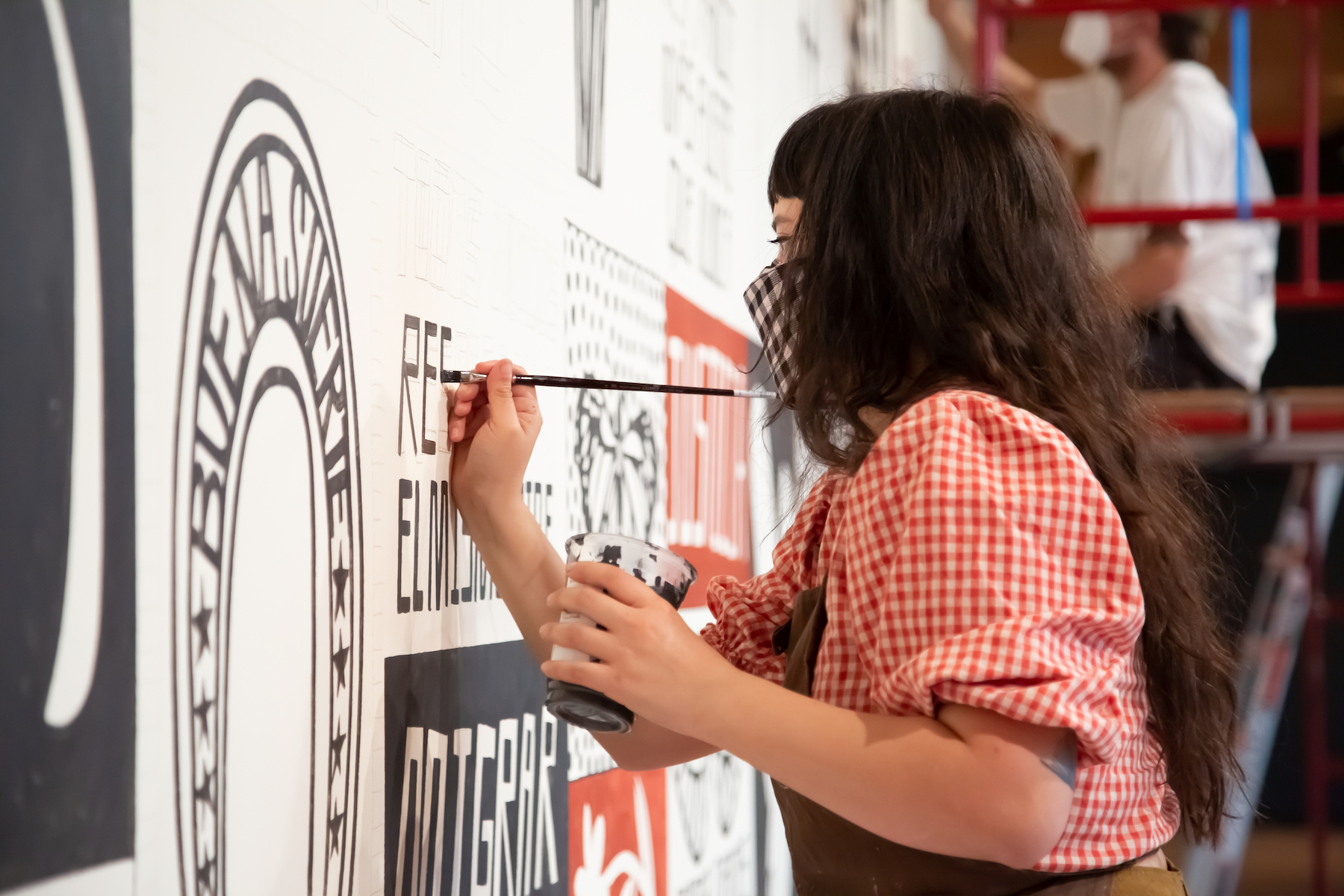Jovanna Venegas, assistant curator of Contemporary Art at the San Francisco Museum of Modern Art, lives at Guerrero and 14th Street in San Francisco. Last year, she noticed a bright pink mural on a boarded up storefront nearby.
“It was in English and Spanish, reminding people to take care and to wash their hands and to remain vigilant,” Venegas said. “Usually there’s not so much messaging in Spanish and this was something that seemed to be very mindful of the Latinx people who live and work in the Mission. It was really beautiful, and I walked by it every day.”
The mural was part of 100 Days Action’s Art for Essential Workers, wheat paste murals in empty storefronts to give artists work, brighten the neighborhood, and thank essential workers. Liz Hernández, an artist from Mexico City, did the mural that Venegas saw, and when the museum started working on the “Bay Area Walls” exhibition, the curator thought of Hernández and her work. She did a masked studio visit with Hernández, who made a sketch for the museum, which was accepted with no revisions.
The mural that came out of the sketch, Conjuro para la sanación de nuestro futuro (A spell for the healing of our future), is now on the museum’s third floor, the first time Hernández, a painter and ceramicist, has had work in a museum.

Done in muted reds, blacks, and browns—earthy colors the artist says she is drawn to—the mural depicts pictures of hearts, hands, eyes, garlic, and corn. Many of the images come from the small, metal charms called milagros (miracles) which are often pinned on the clothing of saint statues, or hung from altars and shrines, and carried for good luck and protection.
Hernández says she started thinking a lot about these charms when she went to see her family in Mexico City for Christmas in 2019, and they visited a lot of churches.
“I got obsessed with milagros, and I bought a lot when I was there,” she said. “I was looking inwards and feeling sort of desperate and not sure who to ask for help. These little charms are a petition to a higher power to ask for help.”
There are a lot of images of lungs in the mural. Hernández says her uncle in Mexico passed away from COVID early on. Also her husband has asthma, and with the wildfires covering much of California, turning the air smoky and making breathing difficult, she was thinking about lungs and their function a lot.
Help us save local journalism!
Every tax-deductible donation helps us grow to cover the issues that mean the most to our community. Become a 48 Hills Hero and support the only daily progressive news source in the Bay Area.
“I was doing a lot of research about them,” she said. “Breathing became this stressful thing, which is so strange because breathing is life.”

Hernández wanted the mural to be about healing. Along with milagros, she was thinking about protection, and she remembered the string of garlic her grandmother had behind her door.
“It had this protection energy,” she said. “I remember it was the last symbol I painted, and it took me so long. My friends were teasing me, saying, ‘You don’t want this mural to end’ And it’s true. Painting the mural was therapeutic for me.”
Hernández started working on the mural with her assistants, Lena Gustafson and Cole Solinge, right after the second shelter in place took effect in the fall. The museum was closed, so it was just her, her friends, and some of the museum staff. Hernández, who hadn’t seen anyone but her husband for months, was happy to have people to talk to. And she found that a lot of the museum staff members—the janitorial workers, the security guards and the installers—wanted to talk about the mural.
“There was one guy, Jorge, who would come at 3 every day to clean, and we would talk about the mural. I just liked having these conversations with him—he shared so much with me,” she said. “He said seeing the image of hands holding each other meant we’ve got to support each other. I’m a complete stranger, and he shared that with me. Then a lot of people asked about the corn. To me, corn represents abundance. Coming from Mexico corn means we’ll be able to feed people.”

Both Venegas and Hernández say they would like people to get hopeful messages for the health and future of the community from the mural’s imagery.
“I think the meaning is just based on what you need,” Hernández said. “Having those conversations with people were amazing and inspired and the connection was the best part for me. I hope it will spark something you might need. That’s the best thing people can get from a mural.”
Conjuro para la sanación de nuestro futuro (A spell for the healing of our future) is on view at SFMOMA, Floor 3. Tickets available here


